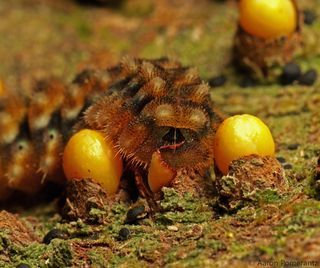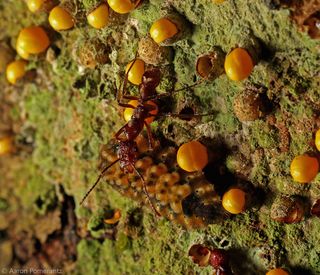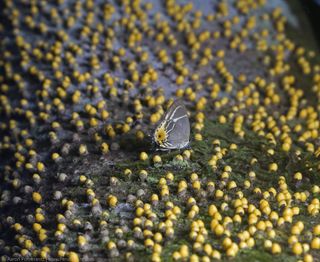A scientist studying in Peru recently found a strange bulb bursting out of a tree in the Amazon jungle. It turned out that the bulb was actually a parasitic plant that flowers just a few weeks a year, and was the backbone of a tiny ecosystem of creatures that survived on it. [Read the full story on the weird parasitic plant]
Yellow dots

While walking in the Amazon in southeastern Peru, Aaron Pomerantz, an field biologist at the Tambopata Research Center, came across a bizarre site: strange yellow bulbs that seemed to burst from the bark of a tree. (Photo credit: Aaron Pomerantz)
Caterpillar interloper

When he took a closer look, he realized that a caterpillar was actually feeding on the bulb. The caterpillar belonged to the family Lycinadae, which is the second-largest family of butterflies. (Photo credit: Aaron Pomerantz)
Fungus or plant?

Though he initially thought the yellow bulb was a fungus, after consulting a number of botanists around the world he realized the bulbs came from a parasitic plant. The plant, which is part of the family Apodanthaceae, is a cryptic species that spends most of its life lurking hidden inside the tree. The yellow bulbs were actually the flowers of this plant, which emerge just a few weeks a year. (Photo credit: Aaron Pomerantz)
Sign up for the Live Science daily newsletter now
Get the world’s most fascinating discoveries delivered straight to your inbox.
Friends with benefits

The caterpillar wasn't the whole story, however. A second look revealed that an ant fed on nectar secreted by the caterpillar from a special organ on its back called the dorsal nectary organ. This relationship may seem like a raw deal for the caterpillar: after all, producing nectar only for someone else to eat it is costly. However, the ant does bodyguard duty, shielding the defenseless caterpillar from hungry wasps and spiders that might otherwise eat it. The relationship may look like symbiosis, but it's actually a more complicated and fraught form called myrmecophily. (Photo credit: Aaron Pomerantz)
Caterpillar morphology

Here, a closeup of the caterpillar's body. The organ on its back, called the dorsal nectary organ, doesn't release nectar all the time. The ant makes the drumming motion on the caterpillar to release a droplet of nectar. (Photo credit: Aaron Pomerantz)
Small scale interaction

The whole drama takes place on a small scale. Here, Pomerantz shows the size of the caterpillar in comparison to his finger. (Photo credit: Aaron Pomerantz)
Butterfly wings

Interestingly, when Pomerantz returned to film the interaction, he noticed a small gray butterfly landing on the bark of the tree. The butterfly had a strange yellow dot on its wing and blended into its background on the tree. That suggested the butterfly had evolved a camouflage that mimicked the tree bark and its parasite, implying that the trio of creatures had a long-term evolutionary relationship. (Photo credit: Aaron Pomerantz)
Follow Tia Ghose on Twitter and Google+. Follow Live Science @livescience, Facebook & Google+.

Tia is the managing editor and was previously a senior writer for Live Science. Her work has appeared in Scientific American, Wired.com and other outlets. She holds a master's degree in bioengineering from the University of Washington, a graduate certificate in science writing from UC Santa Cruz and a bachelor's degree in mechanical engineering from the University of Texas at Austin. Tia was part of a team at the Milwaukee Journal Sentinel that published the Empty Cradles series on preterm births, which won multiple awards, including the 2012 Casey Medal for Meritorious Journalism.












